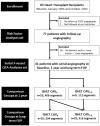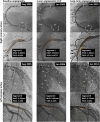Progression of cardiac allograft vasculopathy assessed by serial three-vessel quantitative coronary angiography
- PMID: 30148864
- PMCID: PMC6110499
- DOI: 10.1371/journal.pone.0202950
Progression of cardiac allograft vasculopathy assessed by serial three-vessel quantitative coronary angiography
Abstract
Background: The purpose of the present study was to assess the short- and long-term progression of cardiac allograft vasculopathy (CAV) using serial 3-vessel quantitative coronary angiography (QCA).
Methods: CAV progression was assessed using serial 3-vessel QCA analysis at baseline, 1-year and long-term angiographic follow-up (8.5±3.7 years) after heart transplantation. The change in minimal lumen diameter (MLD) and percent diameter stenosis (%DS) was serially assessed within matched segments. Patients were graded according to the ISHLT-CAV classification and grouped as ISHLT-CAV0 and ISHLT-CAV1-3. The primary endpoint was mean change in MLD and %DS.
Results: A total of 41 patients and 520 matched segments were available for serial 3-vessel QCA. Overall, MLD decreased non-significantly from baseline to 1-year follow-up and significantly from 1-year to the long-term angiographic follow-up (Δ-0.08mm/year [95%CI -0.11 to -0.05], P<0.001). %DS increased significantly from baseline to 1-year (Δ+0.96%/year [95%CI 0.04 to 1.88], P = 0.041) and from 1-year to long-term angiographic follow-up (Δ+0.61%/year [95%CI 0.33 to 0.88], P<0.001). ISHLT-CAV1-3 at 1 year and at long-term angiographic follow-up was observed in 22% and 61%, respectively. Between baseline and long-term angiographic follow-up, a significant reduction in MLD was observed within both groups without a significant difference in the reduction between the two groups (ISHLT-CAV0: median -0.49mm [IQR -0.54 to -0.43] vs. ISHLT-CAV1-3: median -0.40mm [IQR -0.44 to -0.35], P = 0.4).
Conclusion: The current data suggest that QCA can't predict CAV beyond 1 year, but, QCA affirmed that CAV progresses to a similar extent in patients who do not develop visual CAV during long-term follow-up.
Conflict of interest statement
The authors have declared that no competing interests exist.
Figures




Similar articles
-
European Association of Cardiovascular Imaging/Cardiovascular Imaging Department of the Brazilian Society of Cardiology recommendations for the use of cardiac imaging to assess and follow patients after heart transplantation.Eur Heart J Cardiovasc Imaging. 2015 Sep;16(9):919-48. doi: 10.1093/ehjci/jev139. Epub 2015 Jul 2. Eur Heart J Cardiovasc Imaging. 2015. PMID: 26139361 Review.
-
Can the grading of mild cardiac allograft vasculopathy be further refined? An angiographic and physiologic assessment of heart transplant recipients with ISHLT CAV 1.J Heart Lung Transplant. 2025 Jun;44(6):905-912. doi: 10.1016/j.healun.2024.12.013. Epub 2024 Dec 30. J Heart Lung Transplant. 2025. PMID: 39743049
-
Timing of 3-hydroxy-3-methylglutaryl-coenzyme A reductase inhibitor initiation and allograft vasculopathy progression and outcomes in heart transplant recipients.ESC Heart Fail. 2018 Dec;5(6):1118-1129. doi: 10.1002/ehf2.12329. Epub 2018 Jul 17. ESC Heart Fail. 2018. PMID: 30019530 Free PMC article.
-
Long-term mortality after cardiac allograft vasculopathy: implications of percutaneous intervention.JACC Heart Fail. 2014 Jun;2(3):281-8. doi: 10.1016/j.jchf.2014.01.003. JACC Heart Fail. 2014. PMID: 24952696
-
Allograft Vasculopathy: The Achilles' Heel of Heart Transplantation.J Am Coll Cardiol. 2016 Jul 5;68(1):80-91. doi: 10.1016/j.jacc.2016.04.033. J Am Coll Cardiol. 2016. PMID: 27364054 Review.
Cited by
-
Investigation of the Role of Oxidative Stress and Factors Associated with Cardiac Allograft Vasculopathy in Patients after Heart Transplantation.Oxid Med Cell Longev. 2020 Sep 15;2020:7436982. doi: 10.1155/2020/7436982. eCollection 2020. Oxid Med Cell Longev. 2020. PMID: 33014277 Free PMC article.
References
-
- Lund LH, Edwards LB, Kucheryavaya AY, Benden C, Dipchand AI, Goldfarb S, et al. The Registry of the International Society for Heart and Lung Transplantation: Thirty-second Official Adult Heart Transplantation Report—2015; Focus Theme: Early Graft Failure. J Hear Lung Transplant. Elsevier; 2015;34: 1244–1254. 10.1016/j.healun.2015.08.003 - DOI - PubMed
Publication types
MeSH terms
LinkOut - more resources
Full Text Sources
Other Literature Sources
Medical

